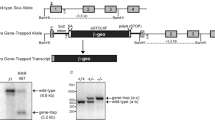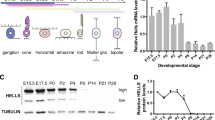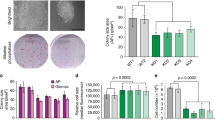Abstract
The retinoblastoma protein RB regulates cell proliferation, differentiation and apoptosis. Homozygous knockout of Rb in mice causes embryonic lethality owing to placental defects that result in excessive apoptosis. RB binds to a number of cellular proteins including the nuclear Abl protein and inhibits its tyrosine kinase activity. Ex vivo experiments have shown that genotoxic or inflammatory stress can activate Abl kinase to stimulate apoptosis. Employing the Rb-null embryos as an in vivo model of apoptosis, we have shown that the genetic ablation of Abl can reduce apoptosis in the developing central nervous system and the embryonic liver. These results are consistent with the inhibitory interaction between RB and Abl, and provide in vivo evidence for the proapoptotic function of Abl.
This is a preview of subscription content, access via your institution
Access options
Subscribe to this journal
Receive 50 print issues and online access
$259.00 per year
only $5.18 per issue
Buy this article
- Purchase on Springer Link
- Instant access to full article PDF
Prices may be subject to local taxes which are calculated during checkout






Similar content being viewed by others
References
Adams PD, Li X, Sellers WR, Baker KB, Leng X, Harper JW et al. (1999). Retinoblastoma protein contains a C-terminal motif that targets it for phosphorylation by cyclin–cdk complexes. Mol Cell Biol 19: 1068–1080.
Agami R, Blandino G, Oren M, Shaul Y . (1999). Interaction of c-Abl and p73alpha and their collaboration to induce apoptosis. Nature 399: 809–813.
Aloisi A, Di Gregorio S, Stagno F, Guglielmo P, Mannino F, Sormani MP et al. (2006). BCR-ABL nuclear entrapment kills human CML cells: ex vivo study on 35 patients with the combination of imatinib mesylate and leptomycin B. Blood 107: 1591–1598.
Alvarez AR, Sandoval PC, Leal NR, Castro PU, Kosik KS . (2004). Activation of the neuronal c-Abl tyrosine kinase by amyloid-beta-peptide and reactive oxygen species. Neurobiol Dis 17: 326–336.
Borges HL, Chao C, Xu Y, Linden R, Wang JY . (2004). Radiation-induced apoptosis in developing mouse retina exhibits dose-dependent requirement for ATM phosphorylation of p53. Cell Death Differ 11: 494–502.
Chau BN, Chen TT, Wan YY, DeGregori J, Wang JY . (2004). Tumor necrosis factor alpha-induced apoptosis requires p73 and c-ABL activation downstream of RB degradation. Mol Cell Biol 24: 4438–4447.
Chau BN, Wang JY . (2003). Coordinated regulation of life and death by RB. Nat Rev Cancer 3: 130–138.
Clarke AR, Maandag ER, van Roon M, van der Lugt NM, van der Valk M, Hooper ML et al. (1992). Requirement for a functional Rb-1 gene in murine development. Nature 359: 328–330.
Darnell GA, Antalis TM, Johnstone RW, Stringer BW, Ogbourne SM, Harrich D et al. (2003). Inhibition of retinoblastoma protein degradation by interaction with the serpin plasminogen activator inhibitor 2 via a novel consensus motif. Mol Cell Biol 23: 6520–6532.
de Bruin A, Wu L, Saavedra HI, Wilson P, Yang Y, Rosol TJ et al. (2003). Rb function in extraembryonic lineages suppresses apoptosis in the CNS of Rb-deficient mice. Proc Natl Acad Sci USA 100: 6546–6551.
Goga A, Liu X, Hambuch TM, Senechal K, Major E, Berk AJ et al. (1995). p53 dependent growth suppression by the c-Abl nuclear tyrosine kinase. Oncogene 11: 791–799.
Goldberg Z, Vogt Sionov R, Berger M, Zwang Y, Perets R, Van Etten RA et al. (2002). Tyrosine phosphorylation of Mdm2 by c-Abl: implications for p53 regulation. EMBO J 21: 3715–3727.
Gong JG, Costanzo A, Yang HQ, Melino G, Kaelin Jr WG, Levrero M et al. (1999). The tyrosine kinase c-Abl regulates p73 in apoptotic response to cisplatin-induced DNA damage. Nature 399: 806–809.
Guo Z, Yikang S, Yoshida H, Mak TW, Zacksenhaus E . (2001). Inactivation of the retinoblastoma tumor suppressor induces apoptosis protease-activating factor-1 dependent and independent apoptotic pathways during embryogenesis. Cancer Res 61: 8395–8400.
Hickman ES, Moroni MC, Helin K . (2002). The role of p53 and pRB in apoptosis and cancer. Curr Opin Genet Dev 12: 60–66.
Jacks T, Fazeli A, Schmitt EM, Bronson RT, Goodell MA, Weinberg RA . (1992). Effects of an Rb mutation in the mouse. Nature 359: 295–300.
Kaufman MH (ed). (1992). Atlas of Mouse Development. Academic Press: UK.
Lasorella A, Noseda M, Beyna M, Yokota Y, Iavarone A . (2000). Id2 is a retinoblastoma protein target and mediates signalling by Myc oncoproteins. Nature 407: 592–598.
Lee C, Chang JH, Lee HS, Cho Y . (2002). Structural basis for the recognition of the E2F transactivation domain by the retinoblastoma tumor suppressor. Genes Dev 16: 3199–3212.
Lee EY, Chang CY, Hu N, Wang YC, Lai CC, Herrup K et al. (1992). Mice deficient for Rb are nonviable and show defects in neurogenesis and haematopoiesis. Nature 359: 288–294.
Lee JO, Russo AA, Pavletich NP . (1998). Structure of the retinoblastoma tumour-suppressor pocket domain bound to a peptide from HPV E7. Nature 391: 859–865.
Levinson NM, Kuchment O, Shen K, Young MA, Koldobskiy M, Karplus M et al. (2006). A Src-like inactive conformation in the abl tyrosine kinase domain. PLoS Biol 4: e144.
Li B, Boast S, de los Santos K, Schieren I, Quiroz M, Teitelbaum SL et al. (2000). Mice deficient in Abl are osteoporotic and have defects in osteoblast maturation. Nat Genet 24: 304–308.
Liu H, Dibling B, Spike B, Dirlam A, Macleod K . (2004). New roles for the RB tumor suppressor protein. Curr Opin Genet Dev 14: 55–64.
Liu X, Clements A, Zhao K, Marmorstein R . (2006). Structure of the human papillomavirus E7 oncoprotein and its mechanism for inactivation of the retinoblastoma tumor suppressor. J Biol Chem 281: 578–586.
Macleod KF, Hu Y, Jacks T . (1996). Loss of Rb activates both p53-dependent and independent cell death pathways in the developing mouse nervous system. EMBO J 15: 6178–6188.
MacPherson D, Sage J, Crowley D, Trumpp A, Bronson RT, Jacks T . (2003). Conditional mutation of Rb causes cell cycle defects without apoptosis in the central nervous system. Mol Cell Biol 23: 1044–1053.
Morgenbesser SD, Williams BO, Jacks T, DePinho RA . (1994). p53-dependent apoptosis produced by Rb-deficiency in the developing mouse lens. Nature 371: 72–74.
Morris EJ, Dyson NJ . (2001). Retinoblastoma protein partners. Adv Cancer Res 82: 1–54.
Nguyen DX, McCance DJ . (2005). Role of the retinoblastoma tumor suppressor protein in cellular differentiation. J Cell Biochem 94: 870–879.
Rubin SM, Gall AL, Zheng N, Pavletich NP . (2005). Structure of the Rb C-terminal domain bound to E2F1-DP1: a mechanism for phosphorylation-induced E2F release. Cell 123: 1093–1106.
Sherr CJ, McCormick F . (2002). The RB and p53 pathways in cancer. Cancer Cell 2: 103–112.
Simpson MT, MacLaurin JG, Xu D, Ferguson KL, Vanderluit JL, Davoli MA et al. (2001). Caspase 3 deficiency rescues peripheral nervous system defect in retinoblastoma nullizygous mice. J Neurosci 21: 7089–7098.
Sionov RV, Moallem E, Berger M, Kazaz A, Gerlitz O, Ben-Neriah Y et al. (1999). c-Abl neutralizes the inhibitory effect of Mdm2 on p53. J Biol Chem 274: 8371–8374.
Takao N, Mori R, Kato H, Shinohara A, Yamamoto K . (2000). c-Abl tyrosine kinase is not essential for ataxia telangiectasia mutated functions in chromosomal maintenance. J Biol Chem 275: 725–728.
Tsai KY, Hu Y, Macleod KF, Crowley D, Yamasaki L, Jacks T . (1998). Mutation of E2f-1 suppresses apoptosis and inappropriate S phase entry and extends survival of Rb-deficient mouse embryos. Mol Cell 2: 293–304.
Tsai KY, MacPherson D, Rubinson DA, Crowley D, Jacks T . (2002). ARF is not required for apoptosis in Rb mutant mouse embryos. Curr Biol 12: 159–163.
Tybulewicz VL, Crawford CE, Jackson PK, Bronson RT, Mulligan RC . (1991). Neonatal lethality and lymphopenia in mice with a homozygous disruption of the c-abl proto-oncogene. Cell 65: 1153–1163.
Vella V, Zhu J, Frasca F, Li CY, Vigneri P, Vigneri R et al. (2003). Exclusion of c-Abl from the nucleus restrains the p73 tumor suppression function. J Biol Chem 278: 25151–25157.
Vigneri P, Wang JY . (2001). Induction of apoptosis in chronic myelogenous leukemia cells through nuclear entrapment of BCR-ABL tyrosine kinase. Nat Med 7: 228–234.
Wang JY . (2000). Regulation of cell death by the Abl tyrosine kinase. Oncogene 19: 5643–5650.
Welch PJ, Wang JY . (1993). A C-terminal protein-binding domain in the retinoblastoma protein regulates nuclear c-Abl tyrosine kinase in the cell cycle. Cell 75: 779–790.
Welch PJ, Wang JY . (1995). Abrogation of retinoblastoma protein function by c-Abl through tyrosine kinase-dependent and -independent mechanisms. Mol Cell Biol 15: 5542–5551.
Woodring PJ, Hunter T, Wang JY . (2003). Regulation of F-actin-dependent processes by the Abl family of tyrosine kinases. J Cell Sci 116: 2613–2626.
Wu L, de Bruin A, Saavedra HI, Starovic M, Trimboli A, Yang Y et al. (2003). Extra-embryonic function of Rb is essential for embryonic development and viability. Nature 421: 942–947.
Xiao B, Spencer J, Clements A, Ali-Khan N, Mittnacht S, Broceno C et al. (2003). Crystal structure of the retinoblastoma tumor suppressor protein bound to E2F and the molecular basis of its regulation. Proc Natl Acad Sci USA 100: 2363–2368.
Yuan ZM, Huang Y, Ishiko T, Kharbanda S, Weichselbaum R, Kufe D . (1997). Regulation of DNA damage-induced apoptosis by the c-Abl tyrosine kinase. Proc Natl Acad Sci U S A 94: 1437–1440.
Yuan ZM, Shioya H, Ishiko T, Sun X, Gu J, Huang YY et al. (1999). p73 is regulated by tyrosine kinase c-Abl in the apoptotic response to DNA damage. Nature 399: 814–817.
Zacksenhaus E, Jiang Z, Chung D, Marth JD, Phillips RA, Gallie BL . (1996). pRb controls proliferation, differentiation, and death of skeletal muscle cells and other lineages during embryogenesis. Genes Dev 10: 3051–3064.
Ziebold U, Reza T, Caron A, Lees JA . (2001). E2F3 contributes both to the inappropriate proliferation and to the apoptosis arising in Rb mutant embryos. Genes Dev 15: 386–391.
Acknowledgements
We thank Rimma Levenzon for technical support. HLB is supported by CNPq (Brazil). This study was funded by a grant from the National Institutes of Health, USA to JYJW (CA58320).
Author information
Authors and Affiliations
Corresponding author
Rights and permissions
About this article
Cite this article
Borges, H., Hunton, I. & Wang, J. Reduction of apoptosis in Rb-deficient embryos via Abl knockout. Oncogene 26, 3868–3877 (2007). https://doi.org/10.1038/sj.onc.1210157
Received:
Revised:
Accepted:
Published:
Issue Date:
DOI: https://doi.org/10.1038/sj.onc.1210157
Keywords
This article is cited by
-
Glioblastoma cells inhibit astrocytic p53-expression favoring cancer malignancy
Oncogenesis (2014)
-
Genetic disruption of Abl nuclear import reduces renal apoptosis in a mouse model of cisplatin-induced nephrotoxicity
Cell Death & Differentiation (2013)
-
Retinoblastoma protein: a central processing unit
Journal of Biosciences (2009)
-
DNA damage-induced cell death: lessons from the central nervous system
Cell Research (2008)
-
Cellular mechanisms of tumour suppression by the retinoblastoma gene
Nature Reviews Cancer (2008)



